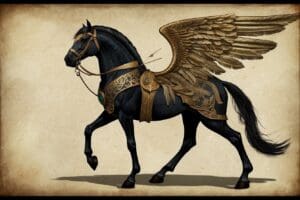Irish Cuisine: Uncovering the Origins of Ireland’s Culinary Heritage
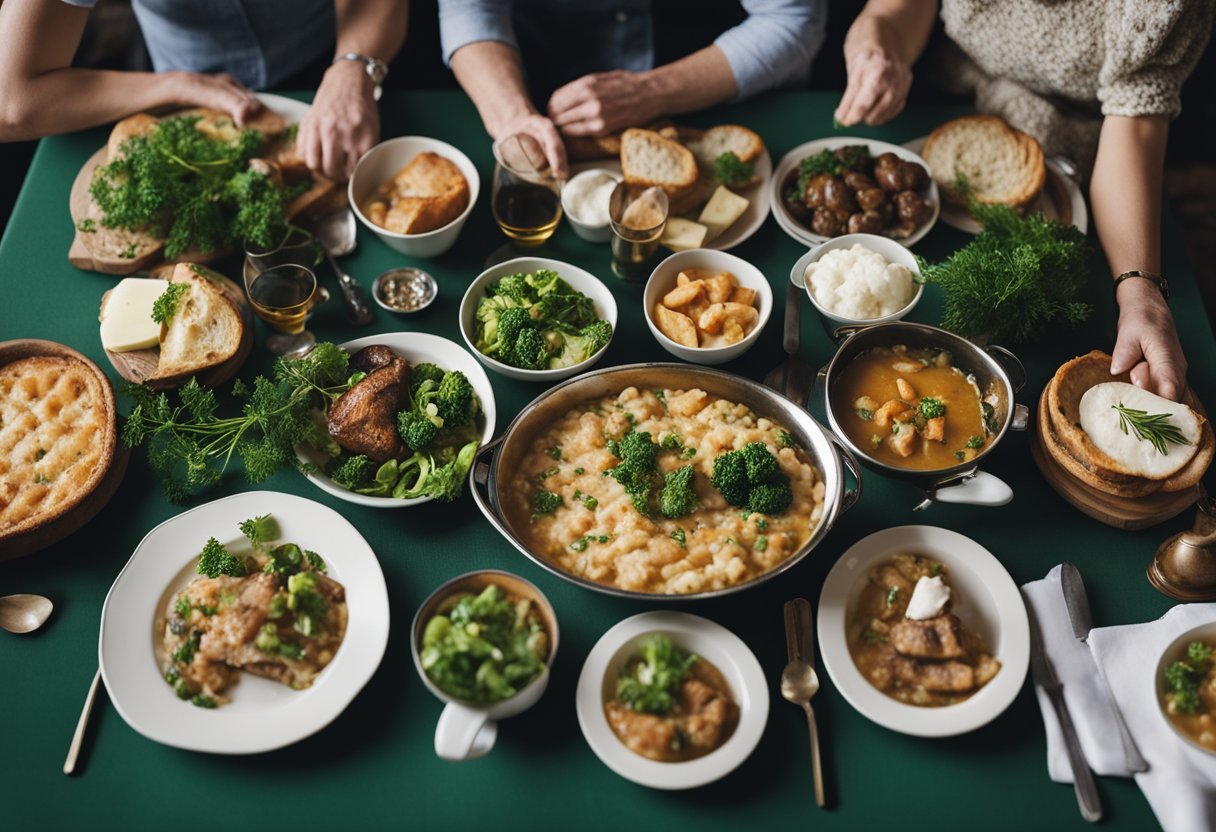
Updated On: March 14, 2024 by Maha Yassin
Irish cuisine is a marvellous tapestry woven with history, folklore, and tradition. Every traditional Irish dish tells a story, from the hearty stews that have sustained generations to the festive breads that mark the passage of seasons. Beyond mere sustenance, these age-old recipes offer us a portal to Ireland’s past, with each ingredient and method steeped in the island’s rich cultural heritage.
Our shared meals go beyond mere consumption; they are a communion with our ancestors. Irish tables have long been laden with more than food—they are a feast of cultural significance. When we bite into a scone or sip a warm broth, we’re not just eating. We’re engaging in an act that echoes the superstitions, music, dance, and tales shaping Ireland’s social fabric. These dishes are a bridge to understanding the land and its people, a way to preserve and celebrate a way of life.
Historical Foundations of Irish Cuisine
Before we dive into the details, it’s essential to acknowledge that the historical context of Irish cuisine is deeply intertwined with the island’s agricultural practices and socio-economic events, particularly the Great Famine.
Impact of the Great Famine
The Great Famine, also known as the Irish Potato Famine, was a period of mass starvation and disease in Ireland from 1845 to 1849. The famine was caused by a potato disease known as late blight, which destroyed the potato crop, a staple in the Irish diet. The impact was catastrophic, with approximately a million people dying from starvation and related diseases. This event reshaped not just the population and culture of rural Ireland but also the nation’s relationship with food, leading to a simplification of the Irish diet.
Influence of Irish Agriculture
Due to Ireland’s amenable grass-growth climate, Irish agriculture has long been dominated by pastoral farming. Consequently, dairy and beef became crucial components of the Irish diet. The harvest of crops like oats and barley, alongside the ubiquitous potato before the famine, supported a diet that was hearty and aligned with the demands of agricultural life in Ireland. Even today, traditional Irish dishes reflect this agricultural heritage, emphasising simplicity and using local, seasonal produce.
Traditional Irish Dishes and Their Origins
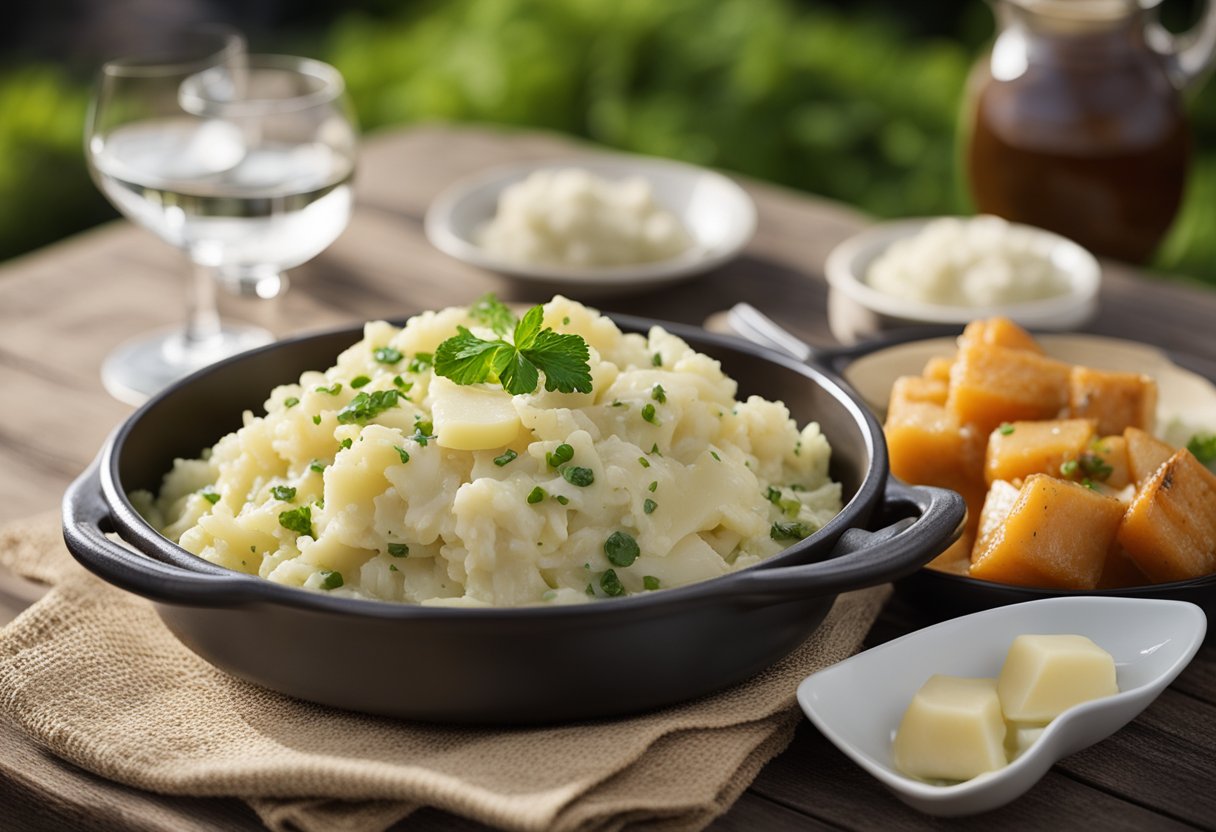
Irish cuisine is not just about sustenance but also storytelling. The origins of Ireland’s traditional dishes are often as hearty and enriching as the foods themselves. This section explores some of the most cherished dishes that have become synonymous with Irish heritage and culture.
Irish Stew: A Hearty Classic
Irish Stew is synonymous with comfort and warm hospitality. Originating when resources were scarce, this one-pot dish was a practical solution for feeding families. Traditionally, it contains lamb or mutton, potatoes, onions, and parsley. Often referred to as a staple during the colder months, Irish Stew holds a special place in the hearts of the Irish, carrying with it myths of ancient hospitality and tradition.
Soda Bread: A Symbol of Hearth
Soda bread is a simple yet profound staple of the Irish table. This uncomplicated loaf, made from flour, baking soda, buttermilk, and salt, speaks to Irish cooks’ ingenuity in using basic ingredients. The cross traditionally cut into the top of the bread before baking isn’t only for aesthetics; it’s also a nod to superstitions and myths, protecting the household and symbolising a warm hearth at the family’s heart.
Colcannon and Champ: Comfort Foods
Colcannon and Champ are cherished comfort foods with their roots firmly planted in the Irish soil. Colcannon, a blend of mashed potatoes and cabbage or kale, is a dish deeply steeped in folklore, especially around the festival of Samhain. It’s known for the tradition of hiding small tokens inside, which are meant to predict the future of those who find them. Champ, similarly homely, is a smooth combination of potatoes and scallions with butter, often enjoyed with a glass of buttermilk. Both dishes are a testament to the resilience and simplicity of the traditional Irish kitchen.
Cultural Significance of Food in Ireland

In Ireland, food is more than sustenance—a narrative of culture interwoven with tradition and social fabric.
From Festivals to Family Tables
Traditionally, Irish festivals like Samhain or St. Patrick’s Day aren’t just marked by parades and music and communal feasting. These family-gathered tables often feature hearty dishes like Irish stew or colcannon, with rich connotations of history and belonging within Irish food culture. Such meals are integral to celebrating festivals and the daily affirmation of our identity.
Food as a Social Connector
Irish society values food as a powerful social connector. From the céilidh to the local pub, sharing a meal or a drink forms the cornerstone of social interaction, binding communities together through stories and songs. The nuances of our social history are often explored through recipes passed down through generations, highlighting food’s central role in Ireland’s cultural tapestry.
Folklore and Mythology in Irish Cuisine
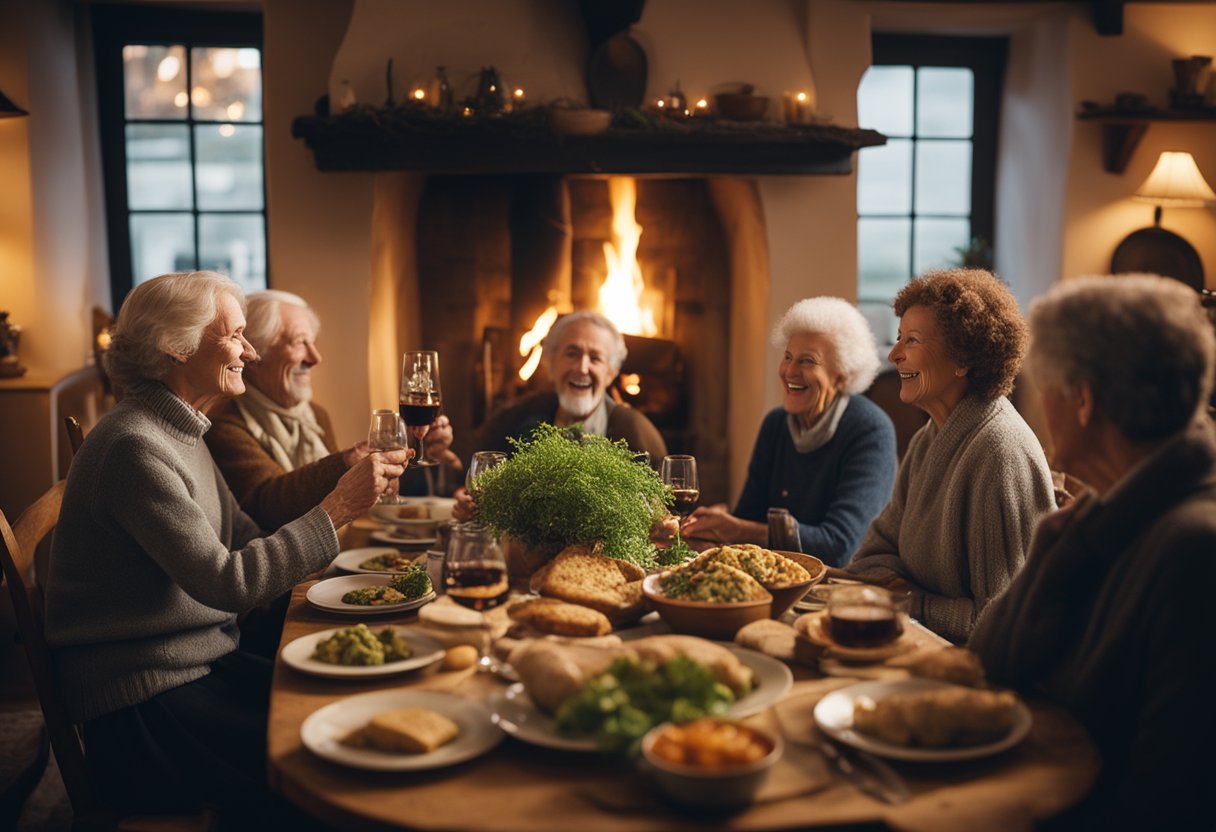
Irish cuisine is more than just sustenance; it vividly narrates the tapestry of Ireland’s cultural mythology and folklore. Dishes serve as vehicles for ancient stories and traditions, providing a delectable connection to the past.
Fairies and Festivities
Ireland’s traditional feasts are often said to be graced by the presence of fairies, enigmatic creatures from the Otherworld. These festivities, especially during Halloween, also known as Samhain, are steeped in practices that originated in mystical tales. During these times, the veil between worlds is thinnest, and food becomes a central medium for communing with the supernatural.
- Halloween dishes: Traditional barmbrack contains hidden charms that can tell the fortunes of those who find them.
Legends Behind Local Ingredients
The ingredients found in Irish dishes often carry their own legends. Wild salmon, for instance, is prominently featured in Irish mythology, embodying wisdom. Tales tell of the Salmon of Knowledge, which bestows great insight upon those who consume it. Seaweed, another local staple, has been used for centuries, with stories highlighting its healing properties and its association with sea deities.
- Wild salmon: Symbolises knowledge, inspired by the legend of the Salmon of Knowledge.
- Seaweed: Touted for health benefits and is noted in folklore for its connection to sea gods.
Preservation of Irish Food Heritage
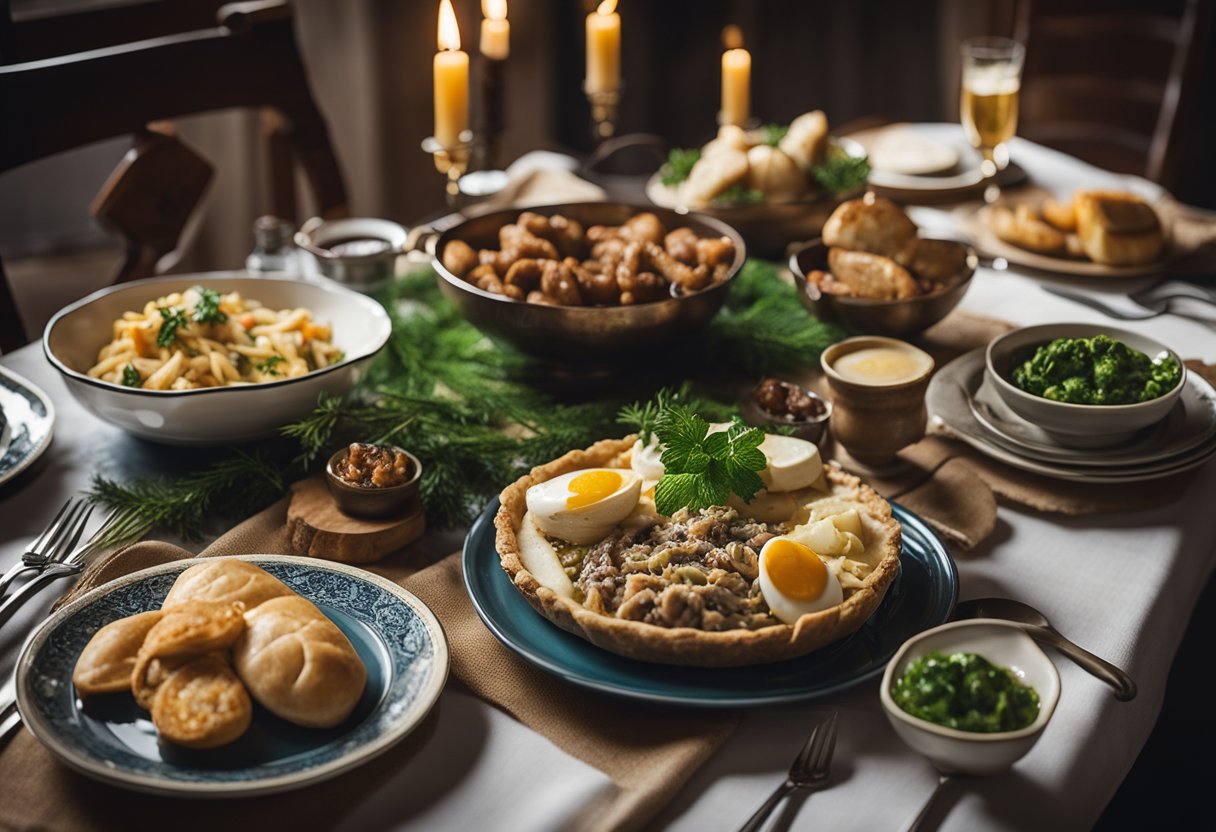
In safeguarding the legacy of Irish culinary traditions, institutions dedicated to preserving cultural heritage play pivotal roles. These entities ensure that the rich tapestry of Ireland’s gastronomic story is not lost to time.
The Role of the Irish Folklore Commission
In our pursuit to preserve Ireland’s culinary past, the National Folklore Collection is instrumental. Formed in 1935, the Irish Folklore Commission has been a guardian of the nation’s oral history, capturing tales and customs associated with Irish dishes. Their extensive archives encompass narratives and recipes that are a testimony to Ireland’s food heritage, illuminating the cultural significance of traditional Irish fare.
UNESCO and Cultural Heritage
UNESCO, the United Nations Educational, Scientific and Cultural Organization, recognises the importance of safeguarding intangible cultural heritage, which includes culinary traditions. Through its Convention for the Safeguarding of the Intangible Cultural Heritage, UNESCO works to ensure these practices are preserved, celebrated, and passed down—contributions that not only enrich our own heritage but also the tapestry of world culture. Our traditional recipes and the rituals that surround them are emblematic of this effort, encapsulating the essence of Ireland’s cultural identity.
Contemporary Irish Food Scene
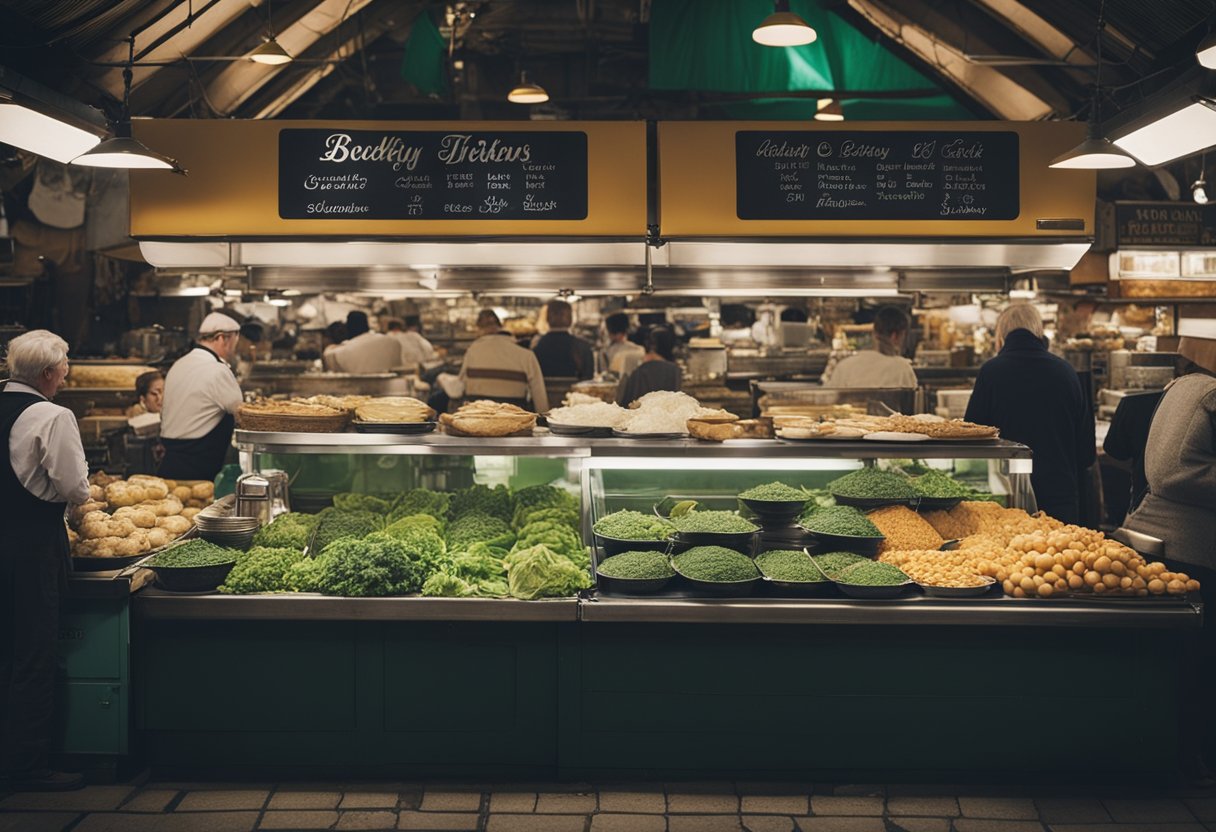
The Irish food scene has embraced transformation, with chefs reimagining traditional recipes and the COVID-19 pandemic prompting shifts in dining experiences.
Modern Takes on Traditional Recipes
In our exploration of the contemporary Irish food scene, it’s evident that there is a renewed interest in authenticity and food studies. Chefs across Ireland are reinventing classic dishes, infusing them with a modern twist while respecting their historical roots. For example, the traditional Irish stew has seen variations that introduce unexpected ingredients, such as artisanal cheese or locally sourced seafood, reflecting society’s evolving palate and curiosity for novel flavours.
Impact of the COVID-19 Pandemic
The COVID-19 pandemic has undeniably acted as a catalyst for change within our society, including how we interact with food. Throughout this challenging period, the Irish food industry has demonstrated remarkable resilience, transitioning from dine-in experiences to innovative takeaway and delivery options. This shift has not only been a testament to the adaptability of our contemporary food culture but has also offered new avenues for people to access culinary delights from the comfort of their own homes.
The Role of Superstitions and Beliefs
In our examination of Ireland’s gastronomic past, we find that superstitions and long-standing beliefs were often ingredients as fundamental as the salt used in their traditional dishes. These elements infused the culinary practices with reverence and added dimension to the dining experience.
Food-related Omens and Customs
Irish tradition bears a rich tapestry of omens and customs that influence various aspects of daily life, including food. For instance, to ensure good luck throughout the new year, it was customary to begin Christmas Day with a hearty slice of bread liberally dotted with caraway seeds. This practice was also mirrored at Halloween, when barmbrack—a fruitcake containing hidden tokens—was served, each object prophesying the future of the person who chanced upon it. Finding a ring symbolised impending marriage, while a coin signified wealth.
The art of butter-making, too, carried certain superstitions. A hot poker would sometimes be thrust into the cream before churning to ward off evil spells, particularly those cast by the envious. This form of “magic” was believed to counteract the evil eye.
Hearth and Home in Irish Tradition
The hearth in an Irish home was more than a source of warmth; it symbolised communal and familial solidarity, where food was prepared and customs thrived. Protection of this sacred space was crucial. A smouldering fire was never left unattended at night without some form of safeguard, often a smidgen of salt scattered among the ashes—thus ensuring that the household remained under a protective aegis.
Likewise, the custom of sharing food, such as offering bread and salt to a new neighbour, stretched beyond a gesture of welcome; it was a profound act expressing the hope that their life in the community would be blessed with abundance and free from hunger. In such ways, superstitions and beliefs were fundamentally woven into the fabric of Irish culinary culture, each dish and technique redolent with meaning.
Influence of Irish Music and Dance on Gastronomy
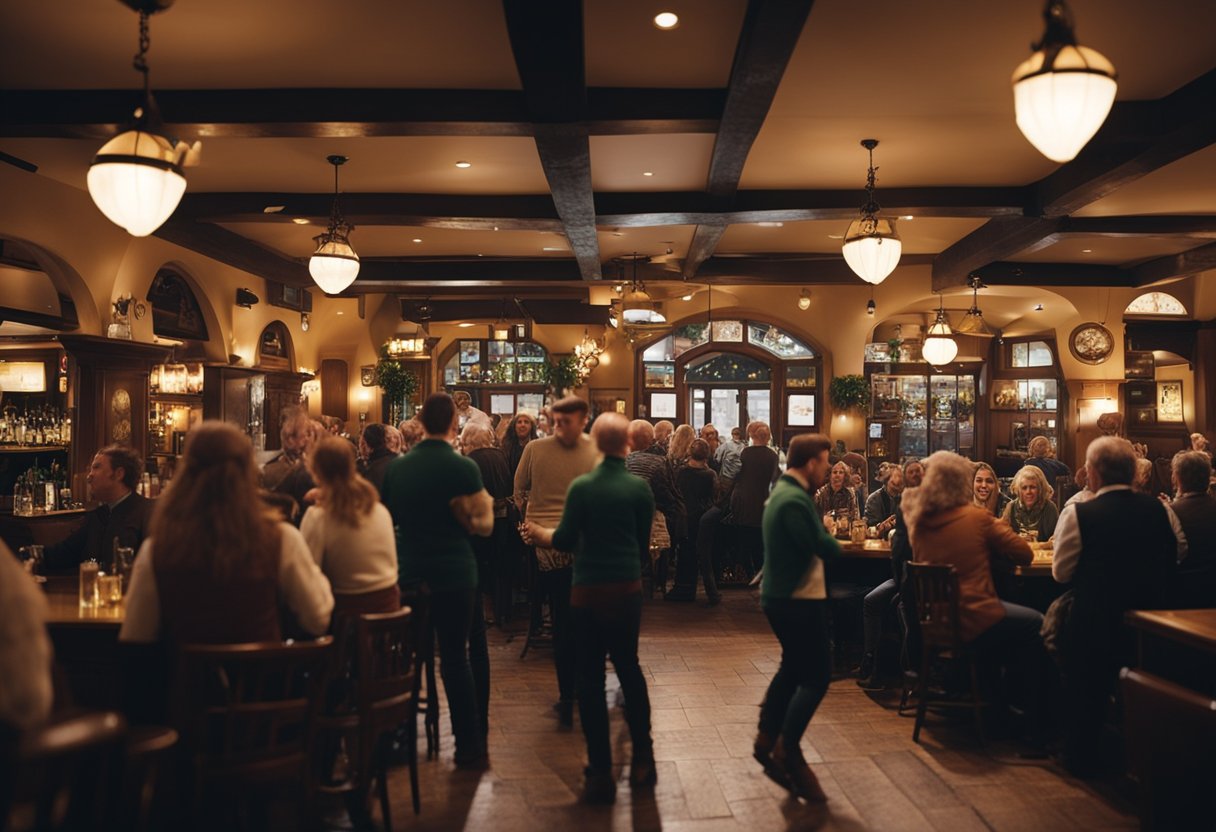
In Irish culture, the intertwining of music, dance, and gastronomy plays a significant role in festivals and gatherings, reinforcing national and cultural identity.
Festival Foods
At Irish festivals, food is more than mere sustenance; it acts as a social glue, bringing people together in celebration. Traditional dishes such as colcannon and soda bread are at special events like St. Patrick’s Day, where ambient music elevates the dining experience. These hearty foods resonate with the vibrant traditions of Irish dance and music, making them a staple at such festivals.
Music and Mealtime
The rhythm of Irish music often sets the pace for meals during gatherings. For example, a lively jig might accompany the preparation of a feast, creating an atmosphere of anticipation. During the meal, slower ballads or traditional Irish folk music can be heard, allowing for fellowship around the table and a chance to share stories. This connection between music and mealtime is pivotal in shaping the cultural identity of Ireland.
Irish Food in Literature and Storytelling
Ireland’s culinary heritage is as rich in narrative as flavour. Our traditional dishes are not just for sustenance but serve as vessels for the stories of our ancestors, encapsulating the wisdom and human experience that have been passed down through generations.
Depictions in Classic Irish Books
In the realm of literature, Irish food acts as a symbol and a setting where characters come to life. The works of James Joyce are peppered with references to quintessential Irish fare that situates the reader in a specific time and place, reflecting the social conditions and the intimate moments of daily life. For example, in Ulysses, Leopold Bloom’s breakfast of a pork kidney marks the beginning of an epic journey through Dublin, mirroring the odyssey of our oral traditions. These books provide a table where the feast of stories ensures that the wisdom of our forebears is savoured with every recollection.
Oral Traditions and Anecdotes
Equally, the oral traditions of Ireland swirl with anecdotes that use food as a metaphor for life’s teachings. We share stories where every meal recounts an adventure, and every ingredient bears a legend—like the infamous Samhain, where colcannon might conceal a lucky charm indicating fortune or marriage. This is not merely food history; it’s the essence of our collective memory, brought to life around the fire, with the lilt of a voice imparting entertainment and life lessons—the very bedrock of our humanity.
Activities and Education in Irish Food History
Exploring the rich tapestry of Ireland’s culinary past, we find various opportunities to immerse ourselves in the nation’s food history through cooking schools and accessible online archives. These resources bring to life the stories encapsulated within traditional dishes, linking them to Ireland’s national identity.
Cooking Schools and Cultural Immersion
Engaging with Ireland’s food history can be both enlightening and delightful. Cooking schools throughout the country offer hands-on experience, demonstrating traditional Irish cooking techniques and recipes. Participants gain practical knowledge of Ireland’s gastronomic heritage, essentially tracing the culinary footsteps of past generations. Additionally, these schools often incorporate aspects of cultural immersion, such as storytelling and music, making the experience truly multifaceted.
One commendable effort to preserve and promote Irish food culture can be seen in the Irish Food Heritage Project at the National Folklore Collection. This initiative emphasises the importance of food in Irish folk traditions, and activities here might include field studies and culinary experiments based on historical practices.
Online Archives and Resources
For those who prefer a digital approach, online archives and resources offer invaluable access to Ireland’s food history. Dúchas.ie is one such portal where a wealth of knowledge awaits. The Schools’ Collection, a component of Dúchas.ie, is a particularly rich resource, providing researched folklore and customs around food that have been collected from across the country.
The Irish Food History Centre also provides comprehensive insights into the evolution of Irish cuisine. One can find meticulously archived articles and guides on various foods, reinforcing the connection between culinary heritage and Ireland’s national identity. The centre’s resources extend education to a broad audience, underscoring the significance of sustaining and celebrating this aspect of cultural heritage.
Irish Food Export and Global Influence
Ireland’s traditional dishes have transcended national borders, becoming integral to our global identity. Among these, Irish whiskey and the shamrock are stellar examples of how national symbols and products can weave Ireland’s story into the fabric of cultures worldwide.
Worldwide Demand for Irish Whiskey
Irish whiskey is celebrated around the globe, with its smooth, triple-distilled production method garnering international acclaim. Exports have soared, linking the spirited warmth of country houses and the rolling greenery of Ireland to countless global destinations. The industry has witnessed exponential growth, with millions of cases filling glasses in over 130 countries. This burgeoning demand speaks volumes about the quality of Irish whiskey, which remains a significant contributor to our national exports.
The Shamrock as an International Symbol
The shamrock, a trefoil plant steeped in our lore, is an emblem of Irish identity that resonates across continents. Its association with St. Patrick and the teaching of Christianity in Ireland has secured its place as a global symbol of Ireland and Irish heritage. On St. Patrick’s Day, the iconic green shamrock finds its way into celebrations worldwide, highlighting our cultural influence and promoting a connection to the Irish diaspora and friends of Ireland. This green emblem, a hallmark of our national identity, festoons everything from pubs to parades, making it a cornerstone of Irish influence abroad.
Frequently Asked Questions
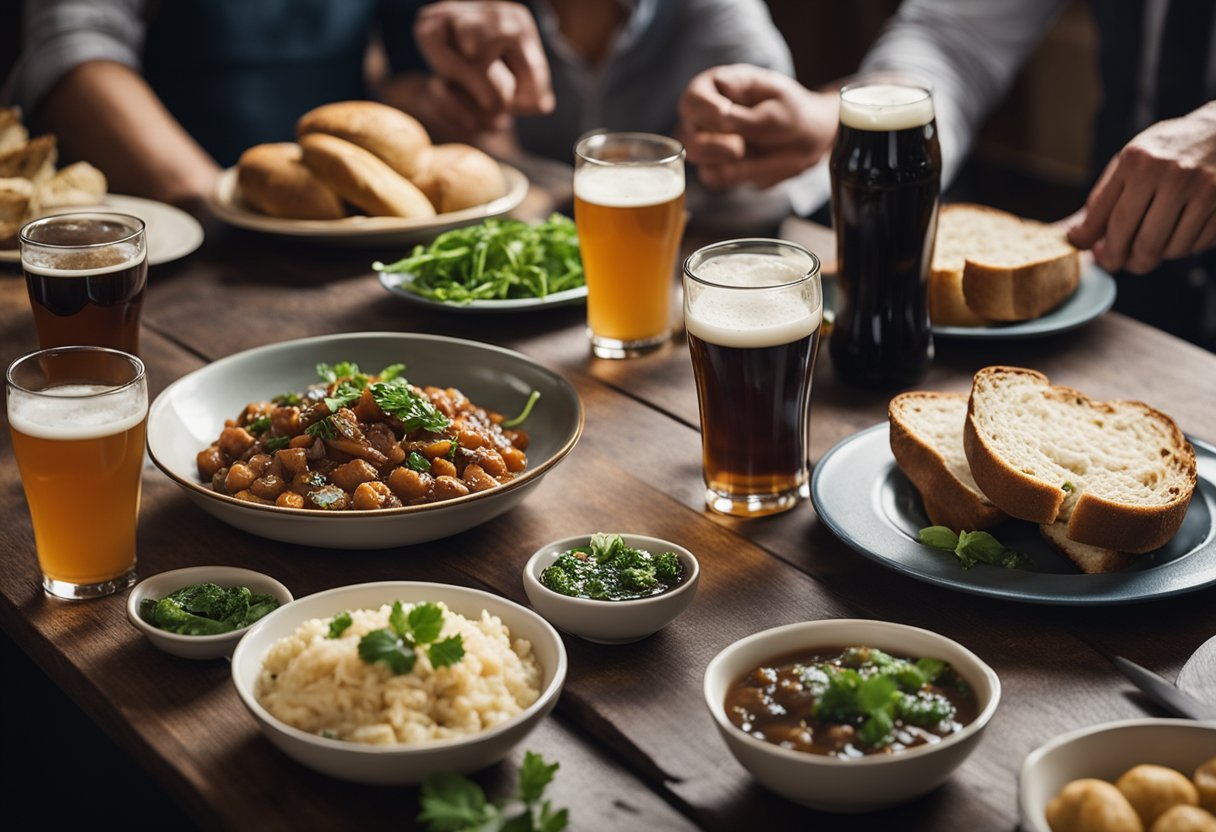
This section offers insight into the quintessential elements and cultural heritage of Ireland’s traditional dishes, revealing the stories and practices that have shaped Irish cuisine.
What ingredients are essential in an authentic Irish stew?
An authentic Irish stew typically comprises root vegetables like carrots and potatoes, onions, and chunks of lamb or mutton simmered in a hearty broth. Parsley or thyme adds a fragrant touch to this age-old dish.
How has the significance of cattle shaped Irish culinary practices over time?
Cattle have been central to Irish farming life, providing meat, milk, and dairy products that form the basis of many traditional Irish dishes. Dishes like beef stews and various cheeses are a testament to this enduring relationship.
What role does folklore play in the preparation of traditional Irish dishes?
Folklore often bestows a mythical quality to food preparation, as seen in the traditional Irish practice of baking barmbrack, which contains various objects predicting the diner’s fortune, or the Halloween tradition of colcannon, which also has fortune-telling charms mixed in.
How has the history of Ireland influenced its food culture and diet?
Ireland’s history, marked by periods of feast and famine, has heavily influenced its food culture. Once a staple, ingredients like potatoes reflect past economic conditions, while the emphasis on fresh, natural products relates to the country’s agrarian past.
In what ways is the traditional dish, boxty, prepared and consumed?
Boxty is a traditional Irish potato pancake made by mixing grated raw potatoes and mashed potatoes with flour, baking soda, buttermilk, and occasionally egg. It can be pan-fried, boiled, or baked and is often served with a dollop of butter or as a side to meats.
Can you trace the history of colcannon and its cultural significance in Ireland?
Colcannon is a beloved Irish dish dating back to the 18th century, made from mashed potatoes and kale or cabbage. It is culturally significant, especially during Halloween, when it serves as a comfort food and a means to partake in festive folklore activities.






